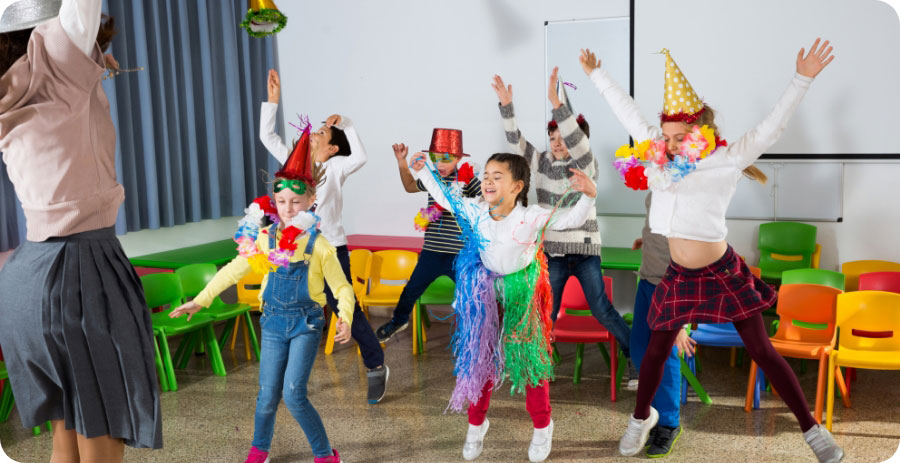School celebrations are a great way to create excitement, build community, and come together to enjoy a break from routine. These celebrations may often include food and beverages high in sugar, salt, or saturated fats. While all foods can be part of these celebrations, it is important to also offer a variety of nutritious options. Schools have the opportunity to role model more inclusive and diverse ways to celebrate special days. For example:
- When offering foods and beverages, aim to offer an assortment of options to help children learn to enjoy and celebrate with variety.
- Consider the diverse dietary needs of students or staff, to ensure that any food-based celebrations are inclusive of those with dietary restrictions. For example, try offering Gluten-free Morning Glory Muffins with cut up seasonal fruit.
- When possible, consider non-food celebration. Check out the list of ideas below for inspiration.
What is Food Neutrality?
“Food Neutrality” refers to keeping a non-judgmental approach when speaking to students about food and beverages. It recognizes that there are many diverse perspectives and experiences around food. Labelling foods as “good” or “bad” or “junk” can place moral judgement on the food, and result in feelings of confusion or shame. If sharing food as part of a classroom celebration, try not to elevate or shame certain foods over others. Instead, talk about food objectively, such as its colour, shape, texture and flavour.
Non-Food Ideas for Classroom Celebrations
Birthdays
- Sing Happy Birthday to the child
- Allow them to choose a story to read at storytime, a craft or activity for the class, or a game to play during gym
- Post their photo on the class bulletin board
- Have students share one thing they like about the student
- Choose one day each month to celebrate all the students’ birthdays
- If food is served consider offering nutritious choices such as smoothies or fruit salad or share cultural foods.
Halloween
- Have students carve pumpkins, parade in their costumes, and dance.
- Share a favourite story or discuss the origin of the celebration.
- Make pumpkin smoothies with canned plain pumpkin puree, bananas, yogurt, and milk or a soy beverage.
Holiday Season
- Have a classroom door decorating competition
- Share holiday music traditions
- Organize a classroom event like:
- a toy drive,
- making cards for children in another country, or
- singing time for seniors in a care home.
Valentine’s Day
- Make cards or bracelets
- Have a classroom door decorating contest
- Paint hearts of symmetry, or have students draw things they love
- Have students write notes of kindness
- Craft up some valen-slime or try a Valentine’s day lava lamp experiment.
Year-End
- Have students create a classroom collage and share friendly messages with each other
- Make a slideshow of photographs highlighting significant events throughout the school year
- Have a year-end dance party
- Organize a special year-end field trip to the beach or a park.
Classrooms Rewards
When foods are given as a reward, children risk associating these foods with emotions and feelings of accomplishment.
Having a positive relationship with food recognizes the many ways food can have social and emotional value in our lives. However, when food is provided as a reward, it can teach children to connect certain foods with feelings of accomplishment. This can send the message that some foods are more special than others. It could also suggest to students that food is “earned” and this can be especially distressing for students experiencing food insecurity. Moving the focus towards intrinsic motivators, such as autonomy, purpose, and mastery, can help a student stay engaged with learning and work hard towards success.
Examples of Intrinsic Motivators:
- Hosting a “genius hour” when students can work on a self-directed project on something they are passionate about.
- Engaging students in activities that create connection with each other (playing games where students can find commonalities, creating their own handless handshakes, “this is us” boards).
- Finding just-right challenges where students can feel they are growing or getting better at something.
- Allowing students to share their learnings with others in the school community.
- Integrating play and fun into classroom activities.
- Setting up a curiosity corner where students can explore the world through hands-on activities or experiments.
Examples of Non-food Extrinsic Motivators:
- School supplies: Pencils or erasers, stickers, books, tickets, or tokens towards a larger prize.
- Special activity time: The class gets time to do a special activity (for example, playing a wide game outside), or work toward a special field trip or a themed day (such as pajama day).
- Recognition: Give a certificate or ribbon. Give a shout-out in the morning announcements or on the morning bulletin board. Recognize the student’s effort during an assembly or circle time.
- Classroom Privileges: Listening to music while working. Sitting next to a friend. Getting extra time for a favoured activity or choosing an element of a classroom activity.
